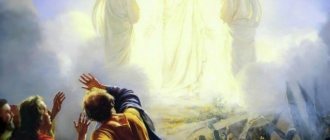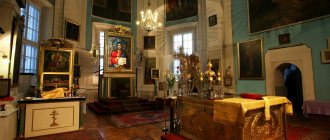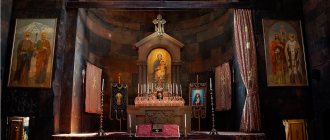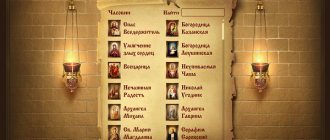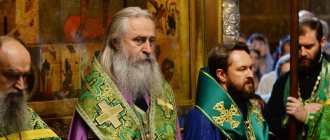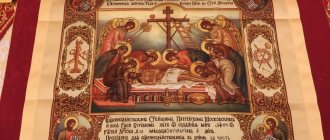This term has other meanings, see Drum (meanings).
Drum
- a cylindrical or multifaceted part of a building that serves as the base for a dome. The lower part of the drum rests on walls or supporting arches that strengthen or support the vaults. Typically, a drum crowns a building not of a rotundal shape, but of a rectangular shape, and to transition from a square base in plan to a round drum in cross-section, either special triangular vaults are used - sails, or trompas[1], that is, niche-shaped vaulted structures at the corners of the square base.
The drum, as a rule, is cut through with elongated windows, and the outside can be decorated with an arcature or arcature-columnar belt and other architectural decorations. The drum is often used in the architecture of domed Christian churches, especially Orthodox ones.
There are two types of drum:
- light - cut through by windows, usually of a rectangular or arch-like shape, the walls between which were often externally equipped with pilasters, columns, carvings, stucco decorations, and in the middle - frescoes.
- deaf (blind) - relatively narrow, without slits. Often such a drum under a dome is called a neckK: Wikipedia: Articles without sources (type: not specified) [ source not specified 1879 days
].
Drums are also the name given to those cylindrical monoliths from which column rods are sometimes made [2].
In the ancient Russian tradition, the drum was called “neck”.
Gallery
- The Trinity Cathedral Troitse Sergiyeva Lavra.jpg
Old Russian churches with cylindrical drums (Trinity Cathedral of the Trinity-Sergius Lavra)
- 112kish.jpg
Church in the village of Kish. Azerbaijan.
- Nikortsminda (7).jpg
Nikortsminda Cathedral. Georgia. Dome drum.
- Gandzasar2.jpg
Gandzasar Temple. Nagorno-Karabakh
- Church of Nativity of the Most Holy Theotokos (Volokolamsk) 14.jpg
Church of the Nativity of the Blessed Virgin Mary (Volokolamsk)
Tambour drum dome
Encyclopedic Dictionary F.A. Brockhaus and I.A. Efron. - St. Petersburg: Brockhaus-Efron. 1890—1907.
See what a “dome drum vestibule” is in other dictionaries:
Tambour, dome drum - (or drum) in architecture a wall of a cylindrical shape or having the form of a multifaceted prism, encircling an empty space, mostly having windows and serving, together with the dome resting on it, as the crown of churches and other buildings. In... ... Encyclopedic Dictionary F.A. Brockhaus and I.A. Efron
TAMBUR - (French tambour drum). 1) a type of crocheting on fabric stretched over a round frame, also crocheting lace, blankets, etc. 2) in architecture: a covered porch, a box at the outer doors. Dictionary of foreign words included in the Russian language... ... Dictionary of foreign words of the Russian language
tambour - a, m. tambour m. 1. military, architectural, obsolete Tambour, drum, there is a kind of traverse at the glacis for communication with flushes. 1777. Kurg. Eng. sl. 2. military, architect. Abshnit; separate fortification in the palisade, in bastions and ravelins in front of the gates and those ... ... Historical Dictionary of Gallicisms of the Russian Language
vestibule - 1. vestibule (in arch.: dome drum; extension at the entrance doors; closed area of a passenger railway car; a type of knitting or embroidery) 2. vestibule and tanbur (stringed musical instrument) ... Russian verbal stress
Architecture of Byzantium - Interior of St. Sophia Cathedral, a masterpiece of Byzantine architecture ... Wikipedia
Byzantine architecture - The transfer of the residence of the Roman emperors to Byzantium by Constantine the Great, which resulted in the collapse of the Roman Empire into two parts and the separation of the East from the West, is one of the most important events in World history in general and history... ... Wikipedia
Byzantium* — Contents: Byzantium colony. Byzantine Empire. Byzantine literature. Byzantine law. Byzantine art. Byzantine coin. Byzantium (Βυζάντιον, Byzantium) a Megarian colony founded in 658 on the European side of the Bosphorus.... ... Encyclopedic Dictionary F.A. Brockhaus and I.A. Efron
Byzantium - Contents: Byzantium colony. Byzantine Empire. Byzantine literature. Byzantine law. Byzantine art. Byzantine coin. Byzantium (Βυζάντιον, Byzantium) a Megarian colony founded in 658 on the European side of the Bosphorus.... ... Encyclopedic Dictionary F.A. Brockhaus and I.A. Efron
Excerpt characterizing the Drum (architecture)
“But you are very friendly with Bolkonsky, he probably wants to convey something,” said the count. - Oh, my God, my God! How good everything was! - And taking hold of the sparse temples of his gray hair, the count left the room. Marya Dmitrievna announced to Natasha that Anatol was married. Natasha did not want to believe her and demanded confirmation of this from Pierre himself. Sonya told Pierre this as she escorted him through the corridor to Natasha’s room. Natasha, pale, stern, sat next to Marya Dmitrievna and from the very door met Pierre with a feverishly shining, questioning gaze. She did not smile, did not nod her head to him, she just looked stubbornly at him, and her gaze asked him only about whether he was a friend or an enemy like everyone else in relation to Anatole. Pierre himself obviously did not exist for her. “He knows everything,” said Marya Dmitrievna, pointing at Pierre and turning to Natasha. “Let him tell you whether I was telling the truth.” Natasha, like a shot, hunted animal looking at the approaching dogs and hunters, looked first at one and then at the other. “Natalya Ilyinichna,” Pierre began, lowering his eyes and feeling a feeling of pity for her and disgust for the operation that he had to perform, “whether it’s true or not, it should be all the same to you, because...” “So it’s not It's true that he is married! - No, its true. – Was he married for a long time? - she asked, - honestly? Pierre gave her his word of honor. – Is he still here? – she asked quickly. - Yes, I saw him just now. She was obviously unable to speak and made signs with her hands to leave her. Pierre did not stay for dinner, but immediately left the room and left. He went around the city to look for Anatoly Kuragin, at the thought of whom all the blood now rushed to his heart and he had difficulty catching his breath. In the mountains, among the gypsies, among the Comoneno, it was not there. Pierre went to the club. In the club everything went on as usual: the guests who had come to dine sat in groups and greeted Pierre and talked about city news. The footman, having greeted him, reported to him, knowing his acquaintance and habits, that a place had been left for him in the small dining room, that Prince Mikhail Zakharych was in the library, and Pavel Timofeich had not arrived yet. One of Pierre's acquaintances, between talking about the weather, asked him if he had heard about Kuragin's kidnapping of Rostova, which they talk about in the city, is it true? Pierre laughed and said that this was nonsense, because he was now only from the Rostovs. He asked everyone about Anatole; one told him that he had not come yet, the other that he would dine today. It was strange for Pierre to look at this calm, indifferent crowd of people who did not know what was going on in his soul. He walked around the hall, waited until everyone had arrived, and without waiting for Anatole, he did not have lunch and went home.
Dictionary of temple architecture
Abse (apse)
– an altar ledge, as if attached to the temple, most often semicircular, but also polygonal; covered with a semi-dome (conch). An altar was placed inside the apse.
Altar
(from Latin “alta ara” - high altar) - the main part of the Christian temple in its eastern part.
In an Orthodox church it is separated by an altar partition or iconostasis. The altar housed a throne - an elevation for the celebration of the main Christian sacrament - the Eucharist. A folding altar
is an icon consisting of several folding boards covered with picturesque images on both sides (diptych, triptych, polyptych).
Altar barrier
- a low wall or colonnade enclosing the altar part of the temple in Orthodox churches (from the 4th century).
Pulpit
- (from Greek) - an elevation in the center of the temple, from which sermons were delivered and the Gospel was read. As a rule, it was surrounded by columns carrying a roof (ciborium).
Arcature belt
– wall decoration in the form of a series of decorative arches.
Flying buttress
- an open semi-arch that serves to transfer pressure to the buttresses of the temple.
Atrium
– a closed courtyard into which the rest of the rooms open.
Atticus
- (from the Greek Attikos - Attic) - a wall erected above the cornice crowning the architectural structure. Often decorated with reliefs or inscriptions. In ancient architecture it usually ends with a triumphal arch.
Basilica
- a rectangular building in plan, divided by columns (pillars) into several longitudinal galleries (naves).
Drum
- a cylindrical or multifaceted upper part of the temple, over which a dome is built, ending with a cross.
Light drum
- a drum, the edges or cylindrical surface of which is cut through by window openings. Head - a dome with a drum and a cross, crowning a temple building.
Baptistery
- baptismal. A small centric building, round or octagonal in plan.
Stained glass
– a picture on glass, an ornament made of colored glass or other material that transmits light.
Gem
- a carved stone with a recessed (intaglio) or convex (cameo) image.
Donjon
– the main tower of a medieval castle.
Deaconnik
- a room in the altar part of an Orthodox church to the south of the altar.
Altar
- a room in the altar part of an Orthodox church to the north of the altar.
Belfry
- a structure built on the wall of a temple or installed next to it with openings for hanging bells. Types of belfries: wall-shaped - in the form of a wall with openings; pillar-shaped - tower structures with a multi-faceted (usually in Russian architecture, octagonal, less often nine-sided) base with openings for bells in the upper tier. In the lower tiers there is often a chamber-type church - a rectangular volume with a covered vaulted arcade, the supports of which are located along the perimeter of the walls.
Zakomara
- (from Old Russian
mosquito
- vault) - a semicircular or keel-shaped completion of a section of a wall, covering the adjacent internal cylindrical (box, cross) vault.
Keystone
- a stone that ends a vault or arched opening.
Campanile
- in Western European architecture, a free-standing tetrahedral or round bell tower.
Canon
- a set of strictly established rules that determine the basic set of subjects, proportions, compositions, designs, and colors for works of art of a given type.
Counterforce
- a vertical massive protrusion of the wall that strengthens the main supporting structure.
Conha
– a semi-dome over the apse, niche. Often made in the form of a shell.
Cross-domed temple
- canonical type of Byzantine Orthodox church. It was a shortened basilica, topped with a dome, and, according to the Apostolic decrees, with the altar facing east.
Cube
– the main volume of the temple.
Dome
– a covering in the form of a hemisphere, an overturned bowl, etc.
ploughshare
- wooden tiles used to cover domes, barrels and other tops of the temple.
Bulb
- a church dome resembling an onion in shape.
Spatula
- a vertical flat and narrow projection of a wall, similar to a pilaster, but without a base and capital.
Luminarium
- a hole in the ceiling of an early Christian temple.
Martyrium
- a type of early Christian memorial temple over the grave of a martyr.
Mosaic
- a favorite type of monumental painting in the Middle Ages. The image is made from pieces of colored glass - smalt, natural stones. The pieces of smalt and stone have an irregular shape; the light on them is refracted many times and reflected at different angles, creating a magical shimmering glow that flutters in the semi-darkness of the temple.
Naos
- the central part of the Byzantine cross-domed church, crowned with the main dome.
Narthex
– an extension on the western side of the temple, giving the building a more elongated rectangular shape. It was separated from the central part of the temple - the naos - by a wall with arched openings leading to each of the naves.
Rib
- an arched rib in Gothic vaults.
Nave
– (from the Greek “neus” - ship) - an elongated room, part of the interior of a church building, limited on one or both longitudinal sides by a number of columns or pillars.
Porch
– a porch and a small platform (usually covered) in front of the entrance to an Orthodox church.
Pilaster
(blade) - a constructive or decorative flat vertical protrusion on the surface of a wall, having a base and a capital.
Podklet
- lower floor of the building.
Curb
- a decorative strip of bricks placed on edge at an angle to the surface of the facade. Has the shape of a saw.
Sail
– an element of a dome structure in the shape of a spherical triangle. The main dome rests on the sails.
Plintha
– flat brick (usually 40x30x3 cm), building material and element of external decorative decoration of temples.
Portal
– a decoratively designed doorway of a building.
Portico
- a gallery on columns or pillars, usually in front of the entrance to a building.
Side chapel
- a small temple attached to the main building of the church, having its own altar in the altar and dedicated to a saint or holiday.
Narthex
- the western part of Orthodox churches at the entrance, where, according to the Charter, some parts of the divine service and services (betrothal, lithium, etc.) are performed. This part of the temple corresponds to the courtyard of the Old Testament tabernacle. The entrance to the vestibule from the street is arranged in the form of a porch - a platform in front of the entrance doors, to which several steps lead.
Sacristy
- a place in the altar or a separate room at a Christian church for storing the liturgical vestments of priests.
Rust
- hewn stone, the front side of which is left roughly trimmed. Rustication imitates the natural texture of stone, creating the impression of special strength and heaviness of the wall.
Rustication
– decorative treatment of the plaster surface of a wall, imitating masonry made of large stones.
Sredokrestie
– the intersection of the central nave of the cross-domed church with the transept.
Travea
- the space of the nave under the vault.
Transept
– transverse nave of the cross-domed church.
Refectory
- part of the temple, a low extension on the western side of the church, which served as a place for preaching and public meetings.
Fresco
– (“fresco” – fresh) – a technique of monumental painting with water paints on damp, fresh plaster. The primer and the fixing (binder) substance are one whole (lime), so the paints do not crumble.
The fresco technique has been known since ancient times. However, the surface of the antique fresco was polished with hot wax (a mixture of fresco with painting with wax paints - encaustic). The main difficulty of fresco painting is that the artist must begin and finish the work on the same day, before the wet lime dries. If corrections are necessary, you need to cut out the corresponding part of the lime layer and apply a new one. The fresco technique requires a confident hand, fast work and a completely clear idea of the entire composition in each part.
Gable
- the completion (triangular or semicircular) of the facade of a building, portico, colonnade, limited by two roof slopes on the sides and a cornice at the base.
Choirs
– an open gallery, a balcony in the second tier of the temple on the western side (or on all sides except the eastern). The choristers were housed here, as well as (in Catholic churches) the organ.
Tent
- a high four-, six- or octagonal pyramidal covering of a tower, temple or bell tower, widespread in the temple architecture of Rus' until the 17th century.
Fly
- a rectangular cavity in the wall.
Apple
– a ball at the end of the dome under the cross.
